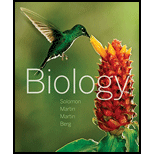
Hermaphroditism (a) is a form of asexual reproduction (b) occurs when an unfertilized egg develops into an adult animal (c) is a form of sexual reproduction in which an animal produces both eggs and sperm (d) typically involves self-fertilization (e) typically requires only a male animal
Introduction: Reproduction is the process by which the organisms propagate their species by the union of the male and females gametes in the case of sexual reproduction or by asexual means which do not involves male and female gametes. Sexual reproduction and asexual reproduction are the two types of reproduction.
Answer to Problem 1TYU
Correct answer: Hermaphroditism is a form of sexual reproduction in which an animal produces both eggs and sperm.
Hence, the correct answer is option (c).
Explanation of Solution
Reason for the correct answer:
Hermaphroditism is a form of sexual reproduction in which an organism has both male and female reproductive systems. They produce both male and female gametes, so any two organisms can mate with any organism and can even self-fertilize. In hermaphrodites, the gametes produced by meiosis have different genetic makeup than the parent organism. It is an adaptation that came during evolution to cope with the challenge of finding a partner, and it became dominant with time. The examples for hermaphrodites include earthworms, snails, and flowering plants.
Option (c) is given as “is a form of sexual reproduction in which an animal produces both eggs and sperm”.
In Hermaphroditism, each individual has both male and female reproductive systems. Thus, it produces both types of gametes (egg and sperm).
Hence, the correct answer is option (c).
Reasons for the incorrect answers:
Option (a) is given as “is a form of asexual reproduction”.
Asexual reproduction is one of the types of reproduction where a single parent produces offspring with identical set of genes. Hermaphroditism is a form of sexual reproduction and not asexual reproduction.
Hence, option (a) is incorrect.
Option (b) is given as “occurs when an unfertilized egg develops into an adult animal”.
The development or growth of the embryo from an egg without fertilization is called as parthenogenesis. It is not a type of sexual reproduction.
Hence, option (b) is incorrect.
Option (d) is given as “typically involves self-fertilization”.
Self-fertilization occurs in a few of hermaphrodite. Self-fertilization is usually prevented in hermaphrodites by developing ovaries and testes at different times.
Hence, option (d) is incorrect.
Option (e) is given as “typically requires only a male animal”.
A hermaphrodite produces both types of gametes (egg and sperm). Thus, they are not referred to a single male animal.
Hence, option (e) is incorrect.
Hence, the options (a), (b), (d), and (e) are incorrect.
In hermaphroditism, each animal produces both types of gametes (egg and sperm).
Want to see more full solutions like this?
Chapter 50 Solutions
Biology (MindTap Course List)
- a. On this first grid, assume that the DNA and RNA templates are read left to right. DNA DNA mRNA codon tRNA anticodon polypeptide _strand strand C с A T G A U G C A TRP b. Now do this AGAIN assuming that the DNA and RNA templates are read right to left. DNA DNA strand strand C mRNA codon tRNA anticodon polypeptide 0 A T G A U G с A TRParrow_forwardplease answer all question below with the following answer choice, thank you!arrow_forwardplease draw in the answeres, thank youarrow_forward
- A) What is being shown here?B) What is indicated by the RED arrow?C) What is indicated by the BLUE arrow?arrow_forwardPlease identify the curve shown below. What does this curve represent? Please identify A, B, C, D, and E (the orange oval). What is occurring in these regions?arrow_forwardPlease identify the test shown here. 1) What is the test? 2) What does the test indicate? How is it performed? What is CX? 3) Why might the test be performed in a clinical setting? GEN CZ CX CPZ PTZ CACarrow_forward
- Determine how much ATP would a cell produce when using fermentation of a 50 mM glucose solution?arrow_forwardDetermine how much ATP would a cell produce when using aerobic respiration of a 7 mM glucose solution?arrow_forwardDetermine how much ATP would a cell produce when using aerobic respiration to degrade one small protein molecule into 12 molecules of malic acid, how many ATP would that cell make? Malic acid is an intermediate in the Krebs cycle. Assume there is no other carbon source and no acetyl-CoA.arrow_forward
 Concepts of BiologyBiologyISBN:9781938168116Author:Samantha Fowler, Rebecca Roush, James WisePublisher:OpenStax College
Concepts of BiologyBiologyISBN:9781938168116Author:Samantha Fowler, Rebecca Roush, James WisePublisher:OpenStax College Biology (MindTap Course List)BiologyISBN:9781337392938Author:Eldra Solomon, Charles Martin, Diana W. Martin, Linda R. BergPublisher:Cengage Learning
Biology (MindTap Course List)BiologyISBN:9781337392938Author:Eldra Solomon, Charles Martin, Diana W. Martin, Linda R. BergPublisher:Cengage Learning Biology 2eBiologyISBN:9781947172517Author:Matthew Douglas, Jung Choi, Mary Ann ClarkPublisher:OpenStax
Biology 2eBiologyISBN:9781947172517Author:Matthew Douglas, Jung Choi, Mary Ann ClarkPublisher:OpenStax Human Biology (MindTap Course List)BiologyISBN:9781305112100Author:Cecie Starr, Beverly McMillanPublisher:Cengage Learning
Human Biology (MindTap Course List)BiologyISBN:9781305112100Author:Cecie Starr, Beverly McMillanPublisher:Cengage Learning Human Physiology: From Cells to Systems (MindTap ...BiologyISBN:9781285866932Author:Lauralee SherwoodPublisher:Cengage Learning
Human Physiology: From Cells to Systems (MindTap ...BiologyISBN:9781285866932Author:Lauralee SherwoodPublisher:Cengage Learning





